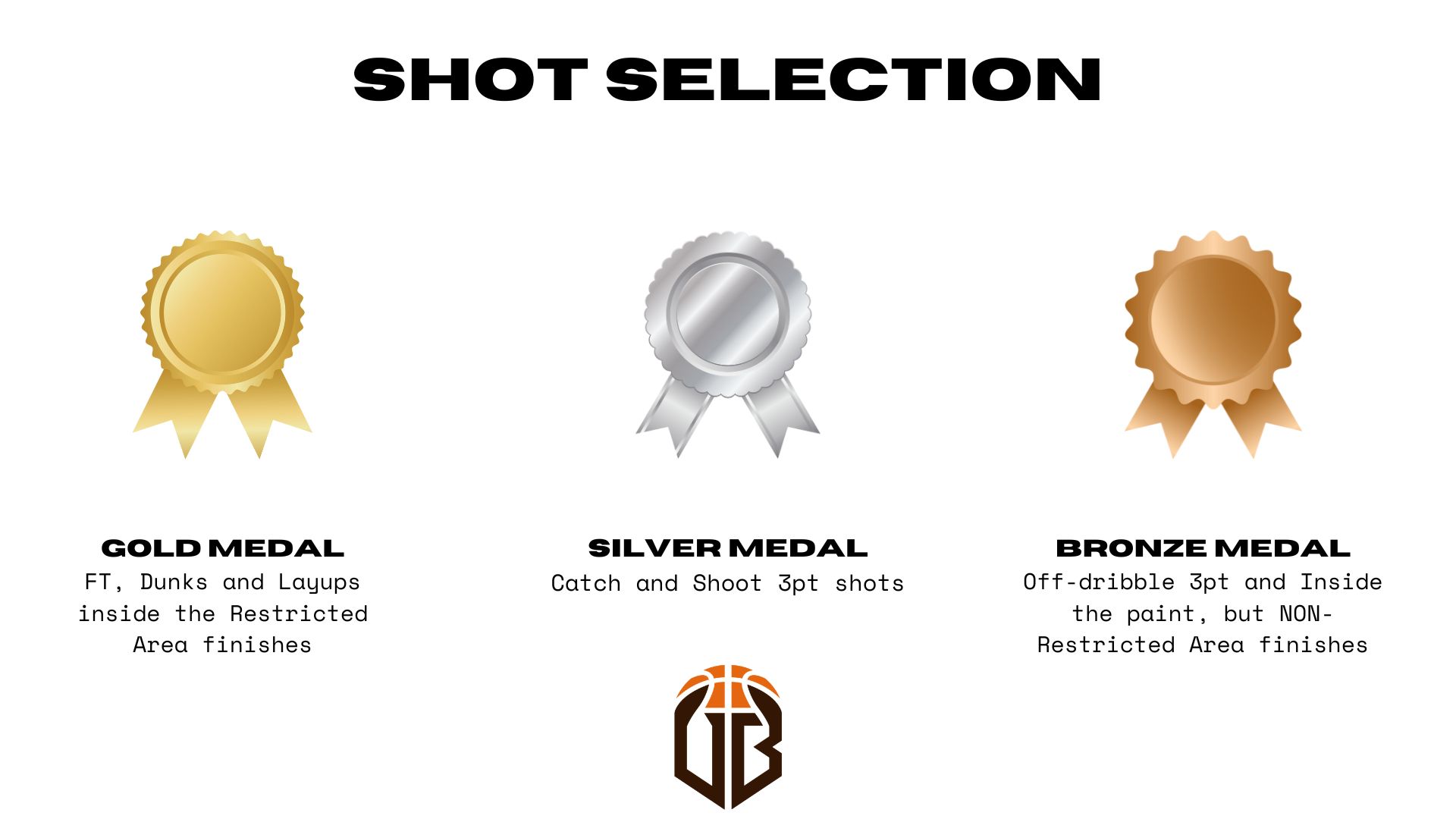Shot Selection: A Key to Efficient Offense
Straight off the bat, anyone reading this information let it be 100% clear that this idea is not new and risen by me but bty Transforming Basketball and Alex Sarama who are the leaders in CLA and DL matters entirely. Credit goes to them in terms of uncovering the following:
Shot selection is an essential component of a team’s offensive success, and it plays a crucial role in guiding individual and collective behaviors on the court. It’s not just about taking any open shot; it’s about understanding which shots offer the highest value and consistently striving to create those opportunities. For teams, this means embracing a defined shot spectrum to ensure efficiency and maximize scoring potential.
Understanding Shot Value
In basketball analytics, there has been extensive discussion about the value of different types of shots. For example, while mid-range shots can occasionally be effective for specific players, they are generally less efficient than alternatives like three-pointers or shots at the rim. Basic math illustrates this: if a player shoots mid-range jumpers at 50% efficiency, it takes 50 shots to score 100 points. Conversely, shooting three-pointers at a suboptimal 30% efficiency requires only 33 attempts to achieve the same total. This discrepancy highlights why higher-value shots—like layups, dunks, and open catch-and-shoot threes—should be prioritized.
The Shot Spectrum
A shot spectrum helps establish the hierarchy of shot quality. At the top of this spectrum are free throws, followed by close-range finishes (layups and dunks), and then catch-and-shoot three-pointers. For younger players, whose range may not yet extend to the three-point line, open mid-range shots can temporarily fill this role. Teams that lack a clear shot spectrum risk allowing players to settle for low-value attempts, such as contested mid-range jumpers, instead of aggressively pursuing higher-value alternatives.
Constraint-Led Approach (CLA) and Shot Selection
Shot selection within the Constraint-Led Approach (CLA) is used as a task constraint to influence how players and teams behave offensively. By constraining practice scenarios to reward only rim finishes and three-pointers, players naturally develop creative solutions to achieve these outcomes. For example, in small-sided games, coaches can incentivize “gold medal” shots (free throws, layups, and dunks) and “silver medal” shots (catch-and-shoot threes), while discouraging heavily contested or off-balance attempts. Such constraints not only improve shot selection but also foster adaptability and problem-solving skills in players.
The ROB Framework
The acronym ROB—“Range, Open, Balanced”—provides a simple guideline for individual shot selection. A ROB shot is one that is within the player’s range, uncontested, and taken in balance. Players should consistently aim to take ROB shots, avoiding contested or off-balance attempts early in the shot clock unless necessary in late-clock situations. This framework can be easily integrated into practices by modifying scoring systems in drills and games to prioritize high-value ROB shots.
Practical Analogies for Teaching Shot Selection
Analogies can be powerful tools for teaching shot selection, especially for youth players. One example is the “Apple Store Analogy,” where different shot types are compared to iPhone models. Players are encouraged to “select” the best models (high-value shots like free throws and open threes) rather than settling for outdated or damaged options (low-value shots like contested fadeaways).
Another analogy involves “gold, silver, and bronze medal” shots. Gold medal shots are fouls, layups, and dunks; silver medal shots are catch-and-shoot threes; and bronze medal shots are off-the-dribble threes or paint twos. While the goal is always to aim for a gold medal, taking a bronze medal shot is preferable to a turnover or shot clock violation when time is running out.
Balancing Team and Individual Needs
While the team’s shot spectrum is vital for overall offensive efficiency, individual player development must also be considered. Players with proven mid-range proficiency should be encouraged to utilize this skill when appropriate. For younger players, however, it’s more important to develop the fundamentals of finishing at the rim, shooting free throws, and hitting open threes. As players progress to higher levels, they’ll need to adapt to tighter defenses and learn to score from deeper ranges or under pressure.
Coaches must also ensure equitable shot opportunities, especially for players still developing their skills. Early-maturing players often dominate youth games due to physical advantages, but this can limit the development of teammates. Ensuring that all players—especially those with long-term potential—get meaningful shot opportunities is crucial for fostering balanced growth within the team.

Encouraging Development Through Constraints
By using constraints in practice, coaches can shape shot selection and encourage the emergence of new skills. For instance, a player overly reliant on three-point shooting might be challenged to attack the rim more frequently. This could be achieved through small-sided games that reward rim finishes or by discouraging long twos. Over time, these constraints can lead to improved adaptability, enhanced spacing habits, and greater creativity in isolation situations.
Conclusion
Shot selection is the linchpin that ties together a team’s offensive principles. Teams that lack a clear strategy risk chaotic play and inefficient scoring. By defining a shot spectrum, leveraging the CLA, and teaching players to value high-quality shots, coaches can elevate both individual and team performance. Whether through structured drills, innovative scoring systems, or engaging analogies, the goal is to instill a mindset that prioritizes efficiency and maximizes success on the court.